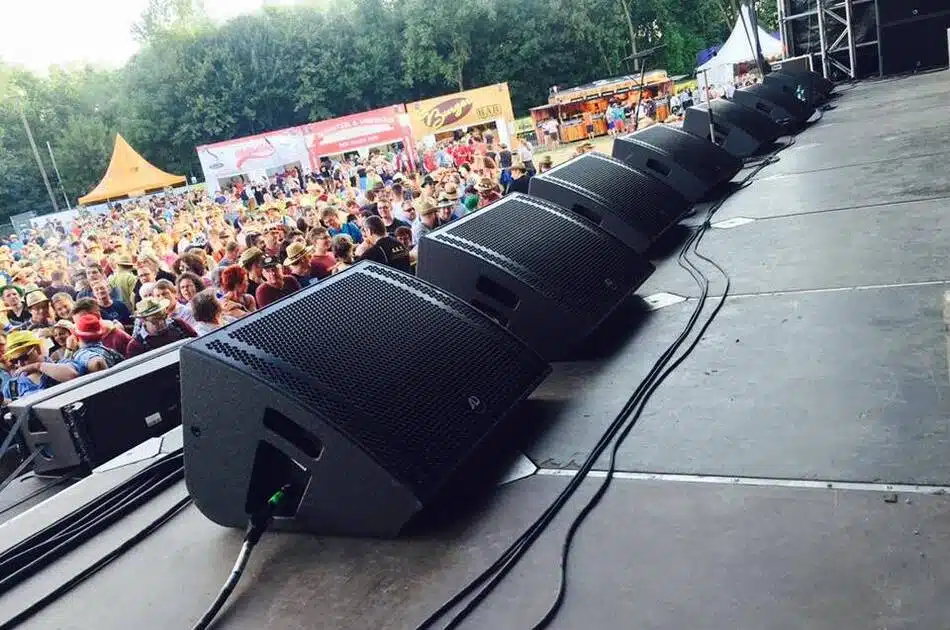
We have all come across stage monitors before, whether we are professional musicians, sound guys, or just an average person who attends concerts and outdoor events.
Stage monitors are the speakers usually found on the stage facing the band. But what exactly do they do, and are they even necessary?
Stage monitors are a necessary component of live audio setups. Stage monitors enable performers to clearly hear themselves and other band members. It helps performers to stay in tune and time with the song being performed. Thus, without stage monitors, it will be difficult for the band to have a good performance.
What exactly are stage monitors, and why are they important? Let me break it down for you.
Table of Contents
What are Stage Monitors?
Stage monitors are basically loudspeakers that are meant for performers and the band. And the main purpose of stage monitors is to allow musicians, performers, and anyone on stage at an event to hear themselves and others loud and clear on stage.
By hearing yourself and other band members and musicians clearly through stage monitors, musicians are able to perform well and in sync.
Stage monitors are positioned in a way that enables performers to hear themselves and other members of the band clearly. Usually, they are placed on the floor and then directed toward the performers or musicians.
Stage monitors are usually connected to the main or front-of-house mixing console, just like the main speakers for the audience. On rare occasions, usually at big events and concerts, stage monitors have their own separate mixer that a monitor engineer controls.
What is The Purpose of Stage Monitors?
The purpose of stage monitors is to serve as a monitoring system for performers or members of a band. They allow musicians, instrumentalists, and other members of the band to clearly hear themselves.
That is why stage monitors are positioned up close to the musicians and performers.
When musicians, performers, and bands perform on stage, they need to hear themselves and their colleagues sing and play in real-time. This helps them to sing in tune and in time, thus sounding like a coordinated unit. All this is possible due to stage monitors.
Unfortunately, this is not possible with PA speakers. I will talk more about why this is so later in this article.
Therefore, one thing you should note is that if musicians do not hear themselves at all or correctly, they will not be able to flow in tune with the rhythm of the song being performed. Their flow and response will not be timed properly as well.
Thus, stage monitors serve as a monitoring system for musicians, instrumentalists, and other band members. They enable every band member to hear and listen to the part they need, sometimes at the volume they want as well.
In fact, most of the time, the type of sound each individual band member needs may differ.
In a large band setup, a bassist may prefer a louder kick in their mix, while the guitarist may prefer otherwise. In such instances, the stage monitor of a bassist may be mixed separately from the guitarist. The same applies to singers.
Generally, singers prefer melodic instruments like the keyboard or guitar to be more prominent in their stage monitor mix to help them stay in time and tune. Therefore, stage monitors enable performers to hear exactly the type of sound that can help them in their stagecraft and in real-time as well.
Therefore, the purpose of stage monitors is to ensure that the member of a band receive the type of sound they require to play in good rhythm and tune.
Why are Stage Monitors Important?
Stage monitors are important because they enable musicians to play on time. But, the truth is, it takes time for sound to travel.
In most event setups, the front, sounding part of PA systems is positioned in the audience’s direction. The musicians and performers tend to be behind these PA systems.
Therefore, if the musicians and performers are at the back end of the PA system, the sound waves transmitted by the PA system will not reach them directly.
These sound waves need to travel all the way to the back of the auditorium first before reflecting backward. Thus, when these sound waves hit a wall, they then travel back past the PA speakers before reaching the performers.
Though sound travels fast, it can take a couple of microseconds for the sound transmitted by PA speakers to reach performers standing behind them.
Though this time delay might seem very small, it is actually a big deal. Imagine watching a movie and the movie’s audio lags behind the visuals by a couple of microseconds. That’s what performers face when no stage monitors are available.
Therefore, without stage monitors, the only way the band will hear is when the sound reflects off the back walls and comes back. Unfortunately, this results in a time delay from the moment input is made to when performers finally hear the sound after it travels and comes back.
This time delay of sound will result in inconsistency and performance mix-up. Thus, stage monitors effectively solve this timing issue.
Do You Need Stage Monitors?
The truth is, stage monitors are a great addition to any live audio setup or event. In fact, having only one or two stage monitors can go a long way to transform the performance of a band significantly.
This is not surprising since stage monitors help performers to hear exactly what they are singing or playing. They also help them hear what other band members are singing or playing. Therefore, having stage monitors as part of your audio setup can make a huge difference to any show.
However, apart from stage monitors, there are other audio devices that performers can rely on to hear themselves and other members of the band.
A great audio device that musicians, instrumentalists, and other band members can rely on to hear themselves and their band members is in-ear monitors (IEMs).
An in-ear monitor is a special type of headphone that live performers usually use. They function primarily like stage monitors. However, in-ear monitors offer sound isolation and give performers the freedom to walk to any part of the stage.
The earpiece of an in-ear monitor has been designed to go into the ear. Due to this, it forms a barrier against outside noise like applause from the audience. Thus, they offer a noise reduction of about 20-40dB.
Most in-ear monitors are designed to be universal fits for every individual. However, the option of acquiring custom-made in-ear monitors is quite common among musicians.
Personally, I use the KZ ZS10 Pro In-Ear Monitor (on Amazon) and they sound incredible. I’m able to hear myself, vocalists, and band members quite clearly without any issues. I would recommend it to anyone looking to pickup a pair of IEMs, especially beginners.
Many churches, bands, and audio engineers are transitioning from stage monitors to in-ear monitors, but stage monitors will still be relevant for years to come.
How Many Stage Monitors Do I Need?
When it comes to the number of stage monitors one may need, there is no specific one-size fit recommendation that can work for everyone. Therefore, I won’t be able to provide you with a numerical criterion that can guide you when setting up stage monitors.
However, I will tell you about the factors that must be considered when deciding on how many stage monitors you may need.
One of these is the size of your setup and band. In fact, the number of stage monitors you may need primarily depends on the size of your setup and band.
For small musical setups where the band members are close to each other, one to three stage monitors may be enough. And they can share the same mix.
On the other hand, if there are lots of band members and they are far apart on a bigger stage, you may need more than three.
However, one thing you should note is that oftentimes, you may not have enough stage monitors for an entire band. That notwithstanding, you need to try as much as possible to achieve sound conditions that are as close to perfect as possible.
Conclusion
In summary, stage monitors are very necessary during live concerts and events. This is because stage monitors help to provide good sound to performers. In addition, the presence of the stage monitors performers to clearly hear themselves and other band members.
This helps them to get their timing right, thus helping them to stay in tune with the rhythm of the song being performed. Therefore, without stage monitors, the quality of the performance of musicians and bands will be quite poor and unexciting.

Hello, I’m Elijah. A writer on Geek Musician, based in Ghana-West Africa. I am a writer with a passion for research and reading. I usually spend my free time playing chess or watching movies. For more info, check out my about me page. Or read more of my articles here.

